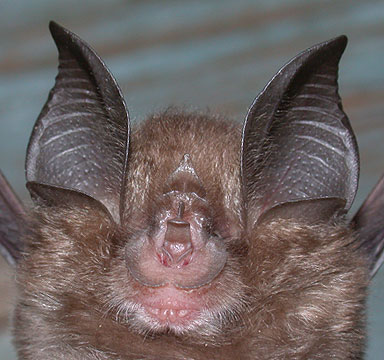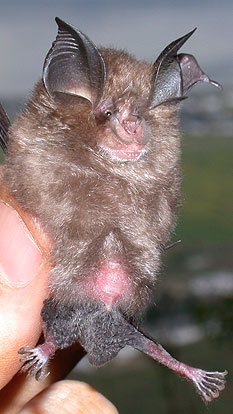Rhinolophus osgoodi
Osgood's Horseshoe Bat
Morphological description Life history Distribution Habitat Roost sites and roosting patterns Emergence and flight pattern Foraging behaviour Echolocation calls Status and protection


Morphological Description
· Dorsal fur is russet-brown above. Ventral fur is more greyish.
· Forearm length 41.0-46.0mm. (Csorba et al. 2003). One bat captured in Yunnan had a forearm length of 45.4mm and a body mass of 6.9g.
· Ear length is 15.3-17.4mm (Csorba et al. 2003), though ours measured 14.3 mm.
· The horseshoe and sella are broad, and the sella appeared sharply concave in profile. The lower lip has 3 mental grooves.
This species had previously only been found by the person who described it - Osgood - near Likiang in China. Osgood (1932) described the bats as 'Rhinolophus lepidus subsp.? and the bat was introduced as a new species by Sanborn (1939). The bat that we captured was found close to the type locality. it was larger than R. pusillus and the echolocation call frequency was distinctive. The taxonomic distinctiveness of this bat needs resolving, especially its relationship to R. lepidus.
Life history
· Little known
Distribution
Only known from Yunnan Province.
Habitat
· We found the bat in a cave at 2100m near Dali. It was torpid when found.
Roost sites and roosting behaviour
· Found in a cave.
Emergence and flight pattern
· Most rhinolophid bats have wing shapes that make them adept at foraging in cluttered environments.
Foraging behaviour
· Nothing known.
Echolocation calls
The echolocation call is a long constant frequency signal, with a brief frequency-modulated start and tail. The frequencies with most energy recorded from a hand-held bat was 95.2 kHz.
Status and protection
· There is no estimation of population size in China.
· Osgood's horseshoe bats is listed as Data Deficient, assessed by the Red List of Threatened Species (IUCN, 2006): the species is currently known only from a limited area in southern China. It is not listed in the Law of the People's Republic of China on the Protection of Wildlife in 1989.
· Caves should be protected as important habitats.